Surfing Adventures Await in Turks and Caicos
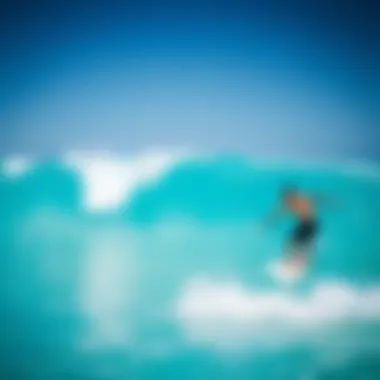
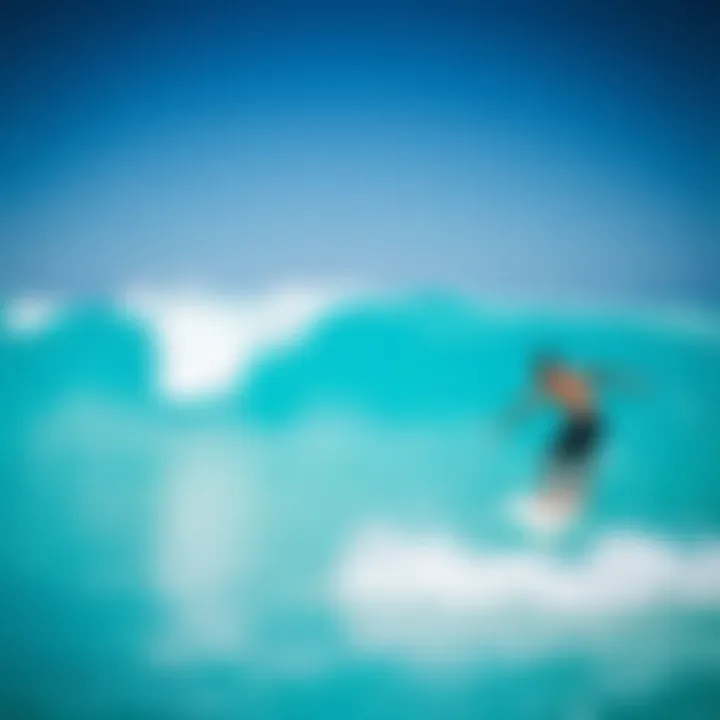
Intro
Turks and Caicos, a gem in the Caribbean, is not just about its powdery white sands and crystal-clear waters. For the adventurous spirit, it offers a unique surfing landscape that can enchant both beginners and seasoned experts alike. The islands can be a canvas for thrill-seekers eager to ride the waves. Surfers find here a blend of favorable weather, picturesque scenery, and diverse marine life, making it a hotspot worth exploring.
Understanding the local environment is key to enhancing your surfing experience. Not only does it help in selecting the right spots, but it also plays a pivotal role in ensuring that surfers respect the surrounding ecosystem. This narrative will guide you through the critical elements of surfing in Turks and Caicos, where you can foster a connection with both the sport and local culture.
Equipment Insights
Having the proper gear can make or break your surfing encounter. Turks and Caicos' sunny backdrop requires specific equipment to maximize enjoyment and ensure safety. With the variety of waves you can expect, it's essential to choose gear suited to different conditions.
Latest Gear Reviews
When it comes to selecting a board, the versatility of a fish tail or shortboard can be beneficial. For instance, the Lost V3 Rocket is a popular choice as it can handle both small and larger waves. Exceptional on turns and smooth in the water, it fits diverse surfing styles. Many local surf shops, like Tropical Surf Co., offer demos so you can see what feels right under your feet.
If you’re serious about performance, considering wetsuits suitable for the tropical climate is vital. Don’t overlook accessories either! Items like FCS surfboard fins can enhance your maneuverability, while impact vests are worth considering if you’re planning to hit the stronger surf.
Essential Gear Maintenance
Maintaining your equipment while enjoying the stunning Turks and Caicos is essential to prolong its lifespan. Rinse the salt off your gear after each use, as salt can corrode and damage your surfboard and accessories. Store your board in a cool, shaded spot to avoid sun damage, and always check for any dings or cracks that may compromise performance.
"The right gear ensures you not only enjoy the thrill of the ride but also contributes to your safety on the water."
Technique Exploration
Understanding the nuances of surfing techniques can prove crucial, especially in a place with varying wave conditions. The Caribbean waters can offer everything from gentle swells to robust waves, catering to all levels of surfers.
Beginner Techniques
For those new to the sport, starting with the basics is a stepping stone toward enjoying the thrill of surfing. A key technique involves learning to pop up from the lying position to a standing one smoothly. Concentrating on your balance as you transition can make a noticeable difference. Additionally, practicing turning your board can greatly enhance your experience in varied surf conditions.
Advanced Maneuvers
As you progress, you may want to incorporate advanced maneuvers. Techniques like the bottom turn and cutback could give you an edge. Bottom turns help gain speed as you move down the face of a wave, while cutbacks allow you to redirect your board back towards the power of the wave. These skills are essential for long rides in the diverse waves found in this region.
To further hone your skills, consider participating in local surf camps tailored to different levels. Engaging with experienced instructors can offer insights invaluable to your growth in the sport.
Understanding the Geography of Turks and Caicos
Understanding the geography of Turks and Caicos is essential for anyone with a keen interest in surfing. The unique features of this tropical paradise shape not only the wave conditions, but also the overall surfing experience. The islands, surrounded by azure waters, create a specific climate that influences swell and wind patterns throughout the year.
If you’re looking to ride some waves, knowing the lay of the land can make a significant difference in your experience. The geography informs not just where to find the best surfing spots, but also what conditions to expect, making it essential knowledge for both novice surfers and seasoned pros alike.
Although the appeal of the serene sandy beaches might be immediately obvious, it’s the interplay of the islands' geography with oceanic elements that truly creates the vibrancy of surfing here.
Islands Overview
Turks and Caicos is an archipelago comprised of 40 islands and cays, only a handful of which are inhabited. The most popular islands for surfers are Providenciales, North Caicos, and Middle Caicos. Each island has its own unique charm and landscape, but they all share the pristine condition of Caribbean waters.
The serenity that envelops these islands enhances the surfing experience, drawing those who seek tranquility allied with adventure. Although the islands are small, their geographical configuration acts like nature's own surfing strategy - with certain areas demonstrating ideal conditions for different skill levels during various times of the year.
Coastal Features and Their Impacts
The coastline of Turks and Caicos has several crucial features that affect surfing conditions. The presence of coral reefs plays a substantial role in shaping wave behavior. These reefs act as breakwaters, ultimately influencing where the ideal waves can be found.
Identifying how these coastal formations impact wave size and consistency is key to a successful surf trip. For instance, many beginning surfers may prefer spots where the waves break gently due to the presence of sandy bottoms, while experienced surfers often seek out more challenging locations nearer to the reefs. Understanding these nuances becomes essential in ensuring a safe and enjoyable surf experience.
Sandy Beaches and Reef Structures
The sandy beaches that border the islands of Turks and Caicos are among some of the most beautiful in the world. Beaches such as Grace Bay and Long Bay Beach are not just pleasing to the eye; they are integral to the surfing ecosystem. The sand serves as an ideal landing for surfers and contributes to the overall wave dynamics in the region.
Additionally, the reef structures that lie just offshore help to form various breaks that cater to a spectrum of surfing styles. This rich environment presents not only recreational opportunities but also presents challenges - and mastering these elements can elevate a surfer’s skill level significantly.
Highlights of the sandy beaches and reef structures in Turks and Caicos include:
- Clear Water: Visibility is often exceptional, which is essential for both surfers and those involved in marine conservation.
- Gentle Slopes: The gradual decline of beaches minimizes dangerous conditions and helps surfers of all levels to engage safely with the waves.
- Diverse Ecosystem: Many surfers appreciate the chance to experience the marine life, like tropical fish and coral formations, that exist in tandem with their sport.
In summary, the geography of Turks and Caicos is central to the surfing experience here; it underpins the practicality of wave forecasts, the best surfing spots, and the unique flora and fauna that make each surfing adventure a remarkable experience.
Wave Conditions in Turks and Caicos
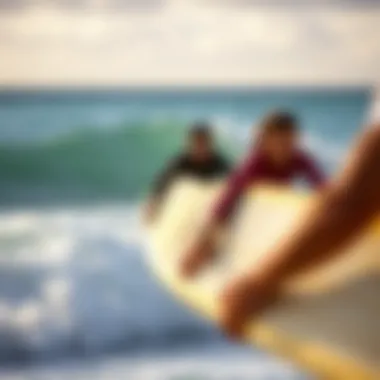
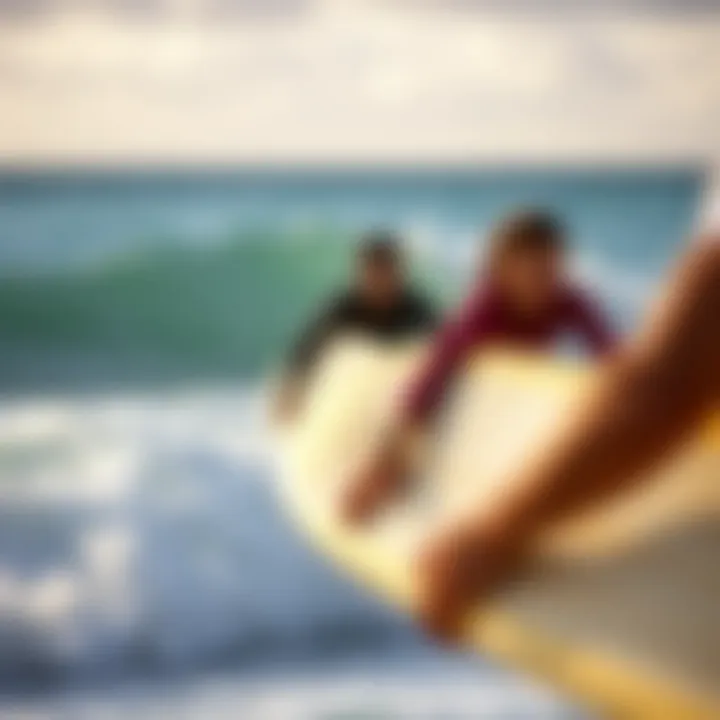
Understanding the wave conditions in Turks and Caicos is crucial for any surfer, novice or seasoned pro. This region offers a unique combination of geographical features that influence not just the size of the waves, but also their rhythm and quality. It's not merely about the thrill of riding a wave. Knowing the specifics can lead to an improved surfing experience, helping to avoid potential hazards while maximizing enjoyment. The right wave conditions can make the difference between a memorable surfing session and a frustrating one.
Understanding the Swell Patterns
To catch the waves at their best, one needs to comprehend the swell patterns that characterize the waters around Turks and Caicos. Swells in this area originate primarily from the North Atlantic. They are generated by powerful storms far away and travel great distances to reach the islands. As these swells approach the shallow reefs, they start to rise, creating fast and punchy waves. Surfers might find the south and east coast more favorable during certain times of the year, especially when the trade winds align perfectly.
Some key factors to consider when assessing swell patterns include:
- Wind Direction: It plays a major role in shaping the swell as well as how consistent the waves will be. Ideally, you'll want offshore winds, which help groom the waves, making them cleaner and easier to ride.
- Fetch: This describes the uninterrupted distance over which the wind blows waves. In Turks and Caicos, a longer fetch typically leads to more powerful swells.
- Seasonality: Wave heights can fluctuate with the seasons. Understanding these nuances allows surfers to time their visits perfectly.
Seasonal Variations in Surfing
The surfing scene in Turks and Caicos is not stagnant, as it is influenced heavily by seasonal variations. Early fall to late spring showcases the best conditions for experienced surfers. This period brings more consistent swells and larger wave sizes, courtesy of winter storms farther north. Conversely, summer may yield smaller swells, making the waters more accessible for beginners and leisure surfers.
Here’s a breakdown of what one can typically expect:
- Fall (September - November): Prime surfing season, with stronger swells especially in October.
- Winter (December - February): Consistently good conditions, great for experienced surfers.
- Spring (March - May): Transition season; swells can still be decent but start to mellow out.
- Summer (June - August): Smaller, gentler waves. Great for beginners, but may disappoint advanced surfers seeking adrenaline-fueled rides.
Ideal Conditions for Different Skill Levels
One of the most significant aspects of surfing is understanding that not all waves fit all surfers. The ideal conditions vary depending on a surfer's skill level; here’s how it breaks down:
- Beginners: They should look for smaller waves that break softly, typically found at beaches like Grace Bay during summer months. Here, the friendly sands and paddling waters offer a safe environment to learn.
- Intermediate Surfers: A good sweet spot would be Long Bay Beach, where moderate waves provide challenges without being too overpowering. This beach can offer both playful breaks and a bit of excitement from time to time.
- Advanced Surfers: They often seek out the northern reefs, as they present the biggest challenges with stronger, faster waves. Spots like Mudjin Harbor can offer these sorts of thrills, especially during the prime of the season.
By taking the time to understand these wave conditions and adapting to the specific needs based on skill level, surfers can enhance their time spent on the water. Remember, each wave carries a story, and being attuned to these environmental cues not only helps in riding better but also fosters a deeper respect for nature.
Popular Surf Spots in Turks and Caicos
The allure of Turks and Caicos for surf enthusiasts is not just about the turquoise waves and sun-soaked beaches. It’s about finding the right spots that cater to diverse skill levels, environmental conditions, and personal preferences. Understanding these popular surf spots is paramount.
Each location offers its own unique charm and set of challenges, making it essential for surfers—both seasoned and budding—to know what to expect. These sites allow individuals to connect not only with the surf but also with the local culture and community.
In this section, we explore four notable spots: Grace Bay, Long Bay Beach, Mudjin Harbor, and Dragon Cay, each having its own flavor to offer.
Grace Bay
Grace Bay is widely regarded as one of the most stunning beaches in the world. The beach stretches out like a picture-perfect postcard, with powdery white sand and crystal-clear waters. For surf enthusiasts, it’s a hot spot that appeals especially to beginners.
- Calm Waters: The waters here are generally gentle, making it easier for those just dipping their toes into the surfing world.
- Accessibility: Numerous surf schools and rental shops are available along the beach. This is particularly beneficial for tourists eager to learn or rent gear without hassle.
- Spectacular Views: When you’re done riding the waves, the scenery is worth soaking in; picturesque sunsets and beachfront hotels create a vibrant atmosphere.
Long Bay Beach
If you’re seeking a more laid-back vibe coupled with slightly more challenging conditions, Long Bay Beach might be your haven. Known for its consistent wind conditions, it’s a favored spot for kiteboarders and surfers alike.
- Wider Space: The beach is expansive, which means you won't feel crowded, allowing for a pleasant and relaxed surfing experience.
- Stronger Swells: With the right wind conditions, more experienced surfers can catch some excellent waves that roll in with vigor.
- Kiteboarding Community: Given its popularity among kiteboarders, this beach often hosts events, providing a chance to observe and learn from seasoned pros.
Mudjin Harbor
Traveling a bit off the beaten path, Mudjin Harbor offers a unique setting that combines stunning cliffs with great surf opportunities. This spot feels more secluded and untouched compared to the more commercialized areas.
- Dramatic Landscape: The cliffs framing the harbor provide an amazing backdrop; this spot isn't just about the waves, it’s a full sensory experience.
- Variable Conditions: Swells here can be less predictable, which may challenge more experienced surfers. However, this unpredictability can also lead to delightful surprises.
- Wildlife: Meanwhile, don’t miss the chance to spot local wildlife—everything from seabirds to playful marine life can be witnessed along the coast.
Dragon Cay
Last but certainly not least, Dragon Cay rounds out the surfing experiences in Turks and Caicos. This spot is often frequented by locals and is less exposed to the tourist crowds.
- Challenging Waves: Typically, Dragon Cay offers more challenging breaks, making it better suited for those with some surfing skills under their belt.
- Rich Local Culture: You�’ll find yourself surrounded by enthusiastic local surfers who are often eager to share tips and insights. Engaging with them can deepen your connection to the culture here.
- Off the Grid: It’s also a place to escape—not just the crowds but to immerse in the beauty of the natural landscape and the essence of island life.
In summary, these surf spots offer more than just waves; they are windows into the heart of Turks and Caicos, reflecting the diverse culture and stunning beauty of this paradise. Choosing the right spot may depend on both your skill level and the experience you wish to have. Whether it’s the vibrant camaraderie at Grace Bay or the more isolated tranquility of Dragon Cay, each location has a story to tell and treasures to unveil.
Surfing Equipment Recommendations
When it comes to enjoying the waves in Turks and Caicos, having the right equipment is a game changer. Proper gear not only enhances your surfing experience but also ensures your safety while you're out in the water. Understanding the essentials among boards, wetsuits, and protective gear is key for both novices and seasoned surfers alike.
Choosing the Right Board
Surfboards are as varied as the surfers who ride them. Selecting the appropriate board is foundational to your experience in the surf. Factors such as your skill level, the type of waves you'll be encountering, and even your personal style play significant roles in this decision.
- Beginner Boards: For those just starting out, a longer board, like a soft-top longboard, offers stability and ease of paddling. It's akin to learning to ride a bike with training wheels—more balance means more fun!
- Intermediate and Advanced Boards: If you have some experience, a shortboard may be ideal. These boards are sleeker and allow for sharper turns, perfect for those exhilarating moments when you've mastered the basics.
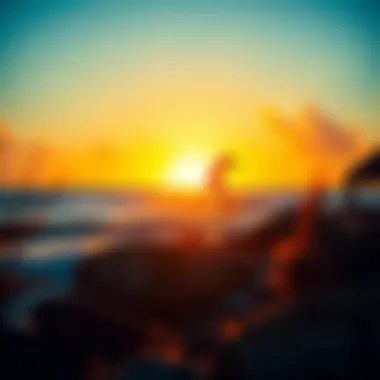

Moreover, it’s crucial to consider the shape and volume of the board. Wider boards with more volume tend to float better, making paddling and catching waves easier. Conversely, narrower boards are suited for performance riding but may require a bit more skill to handle.
Wetsuits and Protective Gear
Although Turks and Caicos is known for its warm waters, having the right wetsuit can still make a significant difference, especially during cooler months or windy days. Different thicknesses cater to varying temperatures. A 2mm shorty might be enough for tropical climates, but if you plan to surf more at night or during colder seasons, a thicker full suit will be more suitable.
- Compression Features: Certain wetsuits provide compression characteristics that enhance blood flow, reducing your risk of fatigue as the day wears on.
- Built-in UV Protection: Since surfers are often exposed to sunlight, choosing wetsuits with UPF ratings can help protect your skin from harmful UV rays.
Additionally, consider protective gear such as rash guards or leg ropes. Rash guards protect against irritation from your board and sunburn, so they are definitely a smart addition to your surfing attire.
Accessories for Comfort and Safety
Ensuring a comfortable and safe surfing experience can be bolstered by incorporating the right accessories. Here are some indispensable items:
- Leashes: A strong, reliable surfboard leash keeps your board close by when you wipe out, preventing it from drifting away and ensuring it's there for you when you resurface.
- Surf Phone Cases: Investing in a waterproof case for your phone allows you to capture those memorable moments without jeopardizing your device.
- Sunscreen: Not just your average bottle, but rather water-resistant and reef-safe formulations can prevent both skin damage and environmental harm.
Keep in mind that while you gear up for your surfing adventure, always prioritize safety and comfort. This will not only enhance your performance but also help cultivate a deeper respect for the waters and surrounding environment of Turks and Caicos.
"The ocean stirs the heart, inspires the imagination, and brings eternal joy to the soul."
Investing in quality equipment showcases a commitment to the sport, enhancing both personal enjoyment and safety on those stunning turquoise waves.
For additional insights and gear comparisons, consider resources like Wikipedia or community discussions on platforms like Reddit. People share their experiences there, helping newcomers and seasoned surfers alike navigate the complex world of surfing gear.
Cultural Relevance of Surfing in Turks and Caicos
Surfing in Turks and Caicos is more than just a sport; it is a significant cultural expression that reflects the islands' rich heritage and communal spirit. This practice resonates with both locals and visitors, fostering bonds that transcend generations. It's crucial to understand how this water sport intertwines with the identity of the islands, showcasing a unique blend of community, competition, and culture.
Local Surfing Community
The local surfing community in Turks and Caicos is vibrant and welcoming, comprised of both seasoned surfers and newcomers eager to embrace the waves. From informal gatherings at popular beaches to organized meet-ups and sessions, locals often share their knowledge and enthusiasm. This camaraderie transforms surfing into a way to build friendships, often leading to enriching exchanges about techniques, experiences, and the very spirit of island life. The community is not just about riding the waves; it also emphasizes the importance of preserving their local environment and coastlines. Together, surfers engage in initiatives aimed at protecting their precious ecosystem, which in turn sustains the very sport they cherish.
"In the water, we’re all on the same team, no matter where we come from. It's about sharing the stoke."
Cultural Events and Competitions
Surf competitions in Turks and Caicos serve as both a showcase of talent and a celebration of community spirit. Events such as the annual 'Turks and Caicos Surfing Championships' bring together surfers from all walks of life, creating an electric atmosphere filled with excitement. These events are not simply about who catches the biggest wave; they are about celebrating local music, food, and culture. Spectators often enjoy a variety of culinary delights while cheering for their favorites. For instance, the blend of rhythmic local musicians and the thrill of surf competition transforms the beach into a festival atmosphere, uniting everyone in shared amusement and pride.
Interaction with Local Traditions
Surfing in Turks and Caicos isn't isolated from local traditions; rather, it integrates seamlessly with the islands' cultural practices. Older generations pass down folklore and stories while teaching the art of riding the waves. Additionally, traditional practices, such as fishing and boat-making, often mingle with the surfing culture, as both share a profound respect for the land and the sea. For example, after a day on the waves, surfers might gather around to share meals made from the day’s catch, fostering a sense of unity and respect for local resources.
In summary, the cultural relevance of surfing in Turks and Caicos is grounded in community bonding, celebration through events, and a deep connection with local traditions. It belies the idea of a solitary sport and instead flourishes within a collective spirit that uplifts the islands’ cultural identity.
Environmental Considerations in Surfing
Surfing in Turks and Caicos isn't just about riding the waves; it's entwined with the environment. As surfers, it's vital to recognize the beauty of the natural world around us and our responsibility to protect it. The islands boast stunning coral reefs and diverse marine life, making it crucial to adopt an eco-conscious mindset. Environmental considerations in surfing not only benefit the ecosystem but also enhance the overall experience for surfers.
Conservation Efforts
Conservation initiatives in Turks and Caicos have been gaining momentum over the years, drawing attention to the importance of safeguarding marine environments. Local organizations and passionate surfers have rallied together to promote awareness and action. Projects like reef restoration and beach clean-ups harness community spirit and enthusiasm.
Being involved in these activities can be immensely fulfilling. Surfers can contribute by volunteering for local conservation programs or participating in educational workshops that inform them about protective measures for marine life. Supporting local conservations ensures that the surf spots remain vibrant and healthy now and for generations to come.
Impact of Tourism on Local Ecosystems
Tourism is a double-edged sword for the islands. While it provides economic opportunities, the resulting influx of visitors can stress local ecosystems. A surge of people can lead to pollution and habitat destruction, particularly around popular surfing areas. Surfers can play a role in mitigating these impacts.
When traveling to surf in the islands, recognizing one's footprint is crucial. Simple practices, like minimizing waste or avoiding single-use plastics, can significantly reduce adverse effects on the environment. Surfers should also be mindful of where they choose to surf—staying away from sensitive habitats helps preserve the delicate balance of the local marine ecosystem.
Sustainable Surfing Practices
Sustainable surfing practices entail making choices that benefit both the surfer and the environment. Opting for eco-friendly surfboards made from sustainable materials is a good start. Many manufacturers are now producing boards that maintain performance while being less harmful to the planet. Additionally, considering locally made equipment can reduce transportation emissions.
Always think about safety gear as well. Choosing wetsuits made from natural rubber or recycled materials decreases personal carbon footprints. Additionally, educating oneself about the local environment—such as understanding tide patterns and currents—can help surfers navigate in ways that minimize ecological disruption.
As passionate surfers, we can protect what we love and ensure our playground remains a paradise for future generations.
The engagement in sustainable practices and awareness of environmental considerations can not only ensure that Turks and Caicos remains a premier surfing destination but also fosters a sense of stewardship that we, as surfers, should embrace.
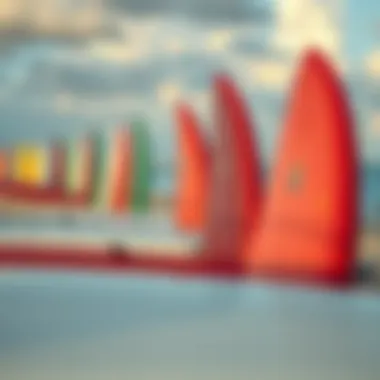

Safety and Etiquette in Surfing
When it comes to riding the waves in Turks and Caicos, the importance of safety and etiquette cannot be overstated. Surfing isn’t just about catching the perfect wave; it’s about understanding your environment and respecting fellow surfers. Practicing safety measures ensures not only your own well-being but also that of others around you. Surfing etiquette helps maintain an enjoyable environment for everyone involved. Both aspects intertwine — a safe surfer is often a more considerate surfer.
Understanding Surfing Etiquette
Surfing etiquette encompasses unspoken rules that help foster a harmonious environment in the water. For starters, one of the key principles is to respect the pecking order determined by the skill level of surfers. When on the waves, if you see someone already riding a wave, don’t paddle in and cut them off. That wave belongs to them; their time in the spotlight should be honored.
- Priority Rights: Respect those already on the wave. If someone is positioned closer to the breaking point, it’s their wave.
- Paddle Out Properly: When paddling out, keep an eye on incoming surfers. Give way to those riding waves and avoid the overlap of paths.
- Clear Communication: A friendly shout or wave goes a long way. If you plan to drop in or share a wave, signal your intentions.
Being aware of these simple rules makes a considerable difference in creating a chill atmosphere. The ocean becomes a gathering place for skill development and camaraderie, rather than rivalry and frustration.
Staying Safe While Surfing
Navigating the waters of Turks and Caicos brings its peculiar set of challenges. Here are a few pointers to keep safety in mind while hitting the surf:
- Check Conditions: Before heading out, always examine the weather reports and surf conditions. Strong currents and unexpected weather changes can transform an inviting surf into a dangerous situation.
- Know Your Limits: Don’t bite off more than you can chew. If a particular spot looks intimidating, it’s perfectly acceptable to find a more suitable wave for your ability.
- Leash Up: Always wear a surf leash. It keeps your board attached to you, minimizing risks to yourself and others.
The waters might be calm one minute, and tumultuous the next. It’s essential to keep a level head and evaluate your surroundings continuously. Make a habit of performing a buddy check with a fellow surfer before venturing out.
Emergency Procedures and Local Resources
Understanding what to do in emergencies could save lives while surfing in Turks and Caicos. Familiarize yourself with local resources, emergency numbers, and protocols:
- Lifeguard Information: Many popular beaches have lifeguards on duty. Knowing their location can provide reassurance if trouble arises.
- Emergency Contacts: In case of severe injuries or accidents, contact local emergency services. Remember, 911 is the general emergency number throughout much of the Caribbean.
- Know How to Signal for Help: If you find yourself in a dangerous situation, signaling with your arm raised can attract attention. If you’re in difficulty, do not hesitate to use your voice clearly to ask for assistance.
Being prepared not only protects you but adds to the safety of the entire surf community. Knowledge is power in the water, and understanding local norms can elevate your experience.
In summary, safety and etiquette are integral to enjoying surfing in Turks and Caicos. Upholding these practices can lead to a rewarding time on the waves, while fostering strong connections within the surfing community.
Travel Recommendations for Surf Enthusiasts
Traveling to surf in Turks and Caicos isn’t just about catching waves; it blends adventure, culture, and relaxation into a single, unforgettable experience. Having the right travel recommendations can make all the difference between a good trip and a fantastic one. From timing your visit to finding suitable accommodations near your favorite surf spots, careful planning ensures you can fully enjoy the pristine waters and vibrant communities. Here are key aspects to consider that can enhance your surfing adventure.
Best Times to Visit for Surfing
When it comes to surfing in Turks and Caicos, not all months are created equal. The best time for surfing largely depends on wind and swell conditions.
- Fall to Spring: Generally, from late October to April, the swells arrive from the North Atlantic, giving rise to consistent waves. During this period, more advanced surfers can enjoy challenging conditions, while novices may find just the right spots for lessons.
- Summer Months: The summer months, especially June through August, tend to provide more relaxed and smaller waves. This makes it an ideal time for beginners or casual surfers looking for a more laid-back surfing experience.
- Consider Hurricane Season: It’s also wise to keep in mind that hurricane season lasts from June to November. While storms can bring in swell, they also come with unpredictable weather; planning around this season is crucial for safety and optimal conditions.
Being aware of these seasonal variations helps surfers find waves that not only fit their skill level but also enhances the overall experience.
Accommodation Options Near Surf Spots
Finding the right place to stay while surfing in Turks and Caicos can lead to convenience that significantly enhances the experience.
- Resorts and Hotels: Numerous resorts like the Beaches Turks & Caicos Resort Villages & Spa provide easy access to surf spots, along with amenities that cater to surfers. Look for places with surf shops on-site for easy gear rentals.
- Vacation Rentals: For those seeking a more homey experience, vacation rentals from platforms like Airbnb are abundant. These often come with kitchens for cooking your own meals, saving money to spend on experiences.
- Surf Camps: For the more adventurous, surf camps provide not only accommodation but also guided surf experiences. These camps often include lessons and all necessary equipment, making them an excellent option for beginners.
Selecting accommodations that offer both comfort and proximity to surf breaks can save valuable time and allow surfers to maximize their wave time.
Local Transportation and Accessibility
Once you have secured a place to stay, knowing how to get around is essential for a smooth and enjoyable surf trip.
- Car Rentals: Renting a car is probably the most convenient option that grants the flexibility to explore various surf spots across the islands. Drive times can be short, allowing surfers to easily chase the best waves of the day.
- Local Transport: If renting a car isn't on the agenda, taxis and rideshare options are available. However, they can add up quickly. Some local surf shops or camps might offer transportation to popular surf spots, a service worth checking out.
- Bicycles and Scooters: For those staying close to their surfing spots, renting bicycles or scooters offers a fun and eco-friendly way to move around. Exploring the islands at a slow pace can also lead to hidden beaches and uncrowded waves.
Overall, understanding and planning your transport can ensure you never miss a prime surfing opportunity, no matter where the waves might lead you.
"Planning your travel can turn good surf trips into great adventures with lifelong memories!"
Overall, thoughtful travel recommendations aren't just small details; they’re essential for creating a fulfilling surfing experience in Turks and Caicos. From choosing the best time to visit, finding cozy habits close to the beach, to figuring out how to get around, careful consideration of these elements can transform your surfing trip into something truly remarkable.
Final Thoughts on Surfing in Turks and Caicos
For enthusiasts, Turks and Caicos offers an environment that fosters both personal growth and respect for nature. Surfers here not only enjoy the thrill of the sport but also contribute to a sustainable future by practicing responsible surfing. The combination of beautiful beaches, the warm waters of the Caribbean, and a welcoming local community make this destination irresistible for surf lovers.
Summary of Key Takeaways
- Geographical Attributes: The islands provide diverse surf spots suited for various levels, making the conditions favorable year-round.
- Cultural Engagement: Surfing is more than a sport here. It’s a way to connect with locals and gain insight into their traditions.
- Environmental Responsibility: With increasing tourism, understanding the environmental impacts enhances the surfing experience while protecting the ocean’s beauty.
- Community Connection: Joining the local surf community encourages camaraderie and sharing of knowledge, vital for newcomers looking to navigate the surfing landscape.
The Future of Surfing in the Region
The future of surfing in Turks and Caicos is promising yet precarious, largely influenced by global climate shifts and tourism trends. As awareness of sustainable practices grows among surfers, there is hope for preserving the rich marine ecosystems vital for the sport. Collaboration among local organizations and environmental groups is crucial in ensuring that developments cater not only to tourism but also to conservation efforts.
New surf schools and eco-friendly accommodations are emerging, reflecting the increasing demand for responsible tourism. Investments in infrastructure improvements will foster better accessibility to surf spots, attracting even more enthusiasts from around the world while safeguarding the environment. Given these considerations, it’s essential for those planning to surf here to stay informed and engaged.
Ultimately, the evolution of surfing opportunities in Turks and Caicos rests on a balance of enjoyment, education, and environmental stewardship. As both locals and visitors navigate the waves, they help shape a future where surfing continues to be both a thrilling and conscientious endeavor.







